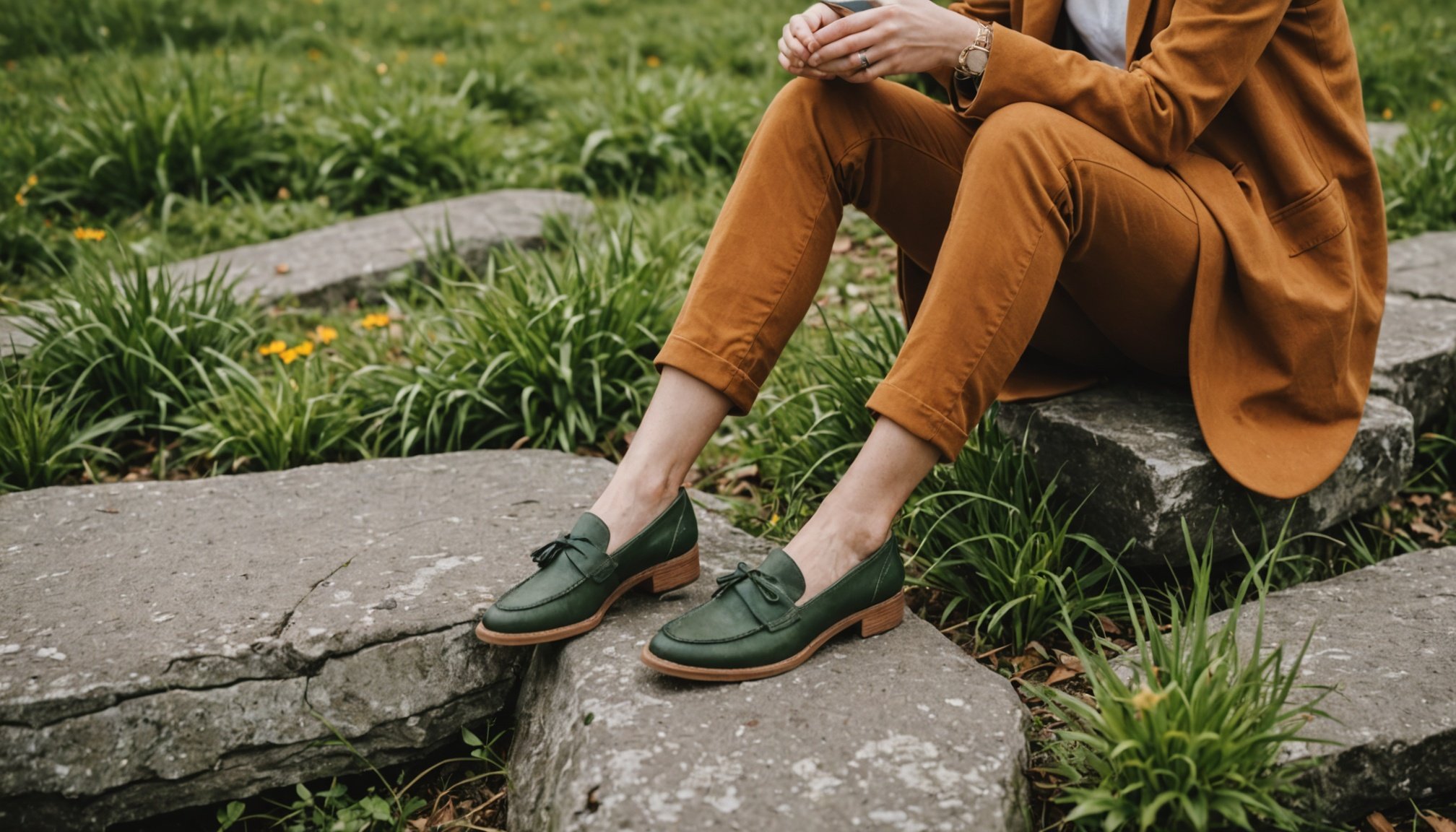Understanding Eco-Friendly Women’s Shoes
Sustainable fashion is more than just a trend; it’s a shift towards conscientious consumer choices that are reshaping the footwear industry. Eco-friendly women’s shoes have become a pivotal part of this movement, responding to the growing awareness of environmental issues. Defined by their use of biodegradable or recycled materials, these shoes aim to minimise environmental harm throughout their lifecycle.
The environmental impact of traditional footwear production is significant, with high carbon emissions, resource consumption, and waste generation. Such production often involves toxic chemicals and non-renewable resources, which contribute to pollution and environmental degradation. This alarming footprint has encouraged manufacturers to pivot towards greener solutions.
In the same genre : Essential Guide: How to Choose a Premium British Wool Sweater
Consumer choices play a crucial role in driving this demand for sustainable fashion. Today’s buyers are more informed and discerning, often opting for products that align with their values of environmental responsibility. As demand increases, companies are motivated to innovate, yielding a diverse range of green footwear options. Shoes made from organic cotton, hemp, and even recycled ocean plastics are now more accessible than ever.
By choosing eco-friendly options, consumers can make a positive environmental impact. This conscious shift not only supports a healthier planet but also encourages the continuous evolution of sustainable practices in the fashion industry.
In the same genre : Exploring the Cutting-Edge Innovations in Sustainable Wool Farming Across the UK
Key Materials Used in Eco-Friendly Women’s Shoes
In the burgeoning market of eco-friendly women’s footwear, the use of sustainable materials is pivotal. Organic cotton is a standout choice due to its minimal impact on the environment. Unlike conventional cotton, organic variants are grown without harmful chemicals, preserving soil health and reducing water usage. Similarly, hemp is a durable and versatile option, praised for its natural resistance to pests and minimal agricultural needs.
The role of recycled materials is equally significant in this arena. Embracing upcycled plastics and textiles not only reduces waste but also lessens the strain on natural resources. By transforming post-consumer waste into new, stylish footwear, manufacturers contribute to a circular economy, harnessing what’s already in circulation.
A comparison between synthetic and natural materials further underscores the advantages of going green. Synthetic materials typically derive from petrochemicals, contributing to carbon emissions and pollution. Conversely, natural fabrics tend to be biodegradable and less energy-intensive to produce, leaving a smaller carbon footprint.
Natural fabrics and recycled materials form the backbone of environmentally conscious choices in women’s shoes, advocating for a shift towards sustainability in fashion. As consumers become more eco-savvy, these materials will likely play a pivotal role in the future of footwear.
Ethical Manufacturing Practices
In the footwear industry, ethical fashion plays a vital role in ensuring fairness and sustainability. Adopting ethical labor practices is crucial to protecting workers’ rights and promoting decent working conditions. Consumers today are increasingly concerned with how their shoes are made and seek transparency from brands about their manufacturing processes.
Identifying Fair Brands
Finding brands committed to fair trade and manufacturing transparency can be challenging. Look for certifications like Fair Trade Certified, which ensure that the brand follows ethical labor practices. Such certifications guarantee that workers receive fair wages and operate in safe environments. Consumers should also research company policies on labor standards and examine any third-party audits they conduct to verify transparency.
Importance of Manufacturing Location
The location of manufacturing significantly impacts a brand’s environmental footprint. Brands manufacturing locally often have lower carbon emissions due to reduced transportation needs. By prioritizing local or ethically-sourced production methods, brands can better control labor practices and ensure that they follow ethical guidelines.
In conclusion, understanding ethical fashion practices involves recognizing brands that are transparent about their manufacturing processes, fair labor laws, and the sustainability of their production methods. This knowledge empowers consumers to make informed choices and support businesses that align with their ethical values.
Comfort and Fit Considerations
When selecting eco-friendly footwear, comfort and fit should be top priorities. A shoe’s design can have a significant impact on your overall well-being. Sustainable shoes often incorporate features such as arch support and cushioning to enhance their ergonomic nature. These elements work in tandem to alleviate foot strain, supporting the natural contours of your feet. A perfectly comfortable shoe should fit snugly, providing support without being restrictive.
Importance of Comfort
Comfort plays a crucial role in eco-friendly footwear as it directly affects foot health and daily comfort. Wearing shoes that accommodate natural foot movement reduces fatigue. It minimizes the risk of long-term issues such as joint pain or misalignment caused by poorly designed shoes.
Features Enhancing Comfort
Eco-friendly brands focus on several features to amplify comfort, such as:
- Arch support for minimizing stress.
- Cushioning to distribute pressure evenly.
- Breathable materials ensuring comfort in various conditions.
Choosing the Right Fit
Selecting the perfect fit involves keen attention to factors like toe space, heel width, and overall snugness. Prioritizing these aspects ensures that footwear promotes healthy foot function, lessening potential for friction or blisters. Always try on options, and walk around to test their ergonomics before making a final decision.
Style Options in Eco-Friendly Women’s Shoes
Navigating the realm of fashionable footwear can be both thrilling and daunting, especially when seeking to align style with sustainability. Recent trends in eco-friendly shoe designs have expanded, offering diverse options that promise both fashion-forward aesthetics and a conscientious touch.
Integrating Sustainability into Everyday Outfits
One of the key aspects of eco-friendly women’s shoes is their adaptability to various wardrobe staples. These versatile styles allow women to seamlessly incorporate them into both casual and formal attire. For instance, sleek, minimalist sneakers crafted from recycled materials can pair effortlessly with jeans or a sundress, while elegant ballet flats in organic natural dyes can complement office wear.
Brands Leading the Trend
Several brands are pioneering in creating stylish yet sustainable options. For example, some manufacturers focus on using renewable resources, like bamboo and cork, in their stylish designs. Others employ upcycled materials, crafting unique and distinctive pieces that stand out. By choosing from such innovative brands, consumers don’t have to compromise on aesthetics to prioritize eco-friendliness.
These developments indicate a positive shift in the fashion industry, where consumers can enjoy the best of both worlds: trendy yet sustainable, and stylish yet ethically produced, putting an end to the age-old dilemma of choosing between style and sustainability.
Recognizing Certifications and Standards
Choosing eco-friendly shoes can be a complex task, especially when trying to discern which certifications and standards genuinely represent sustainable practices. Seeking out Footwear Certifications like the Global Organic Textile Standard (GOTS), which ensures the ecological and social criteria of textiles, is crucial. Similarly, certifications such as the LEED (Leadership in Energy and Environmental Design) tag are also relevant in sustainable shoe manufacturing due to criteria assessing environmental impacts.
Eco-Labels serve as a guiding beacon for consumers eager to make sustainable choices. By simplifying intricate sustainability data, they direct attention to products that minimize environmental impact. Labels such as the EU Ecolabel signify a product’s reduced carbon footprint and adherence to specified environmental directives.
Understanding Sustainability Standards can paint a clearer picture of a brand’s dedication to the environment. For instance, the comparison between brands with multiple certifications reveals the depth of their commitment. A shoe brand embracing standards like Cradle to Cradle Certification indicates significant efforts to consider a product’s full life cycle, from raw material sourcing to recycling.
By paying attention to these certifications, consumers can make informed purchases that align with their values, supporting brands that prioritize eco-conscious approaches.
Comparing Eco-Friendly Shoe Brands in the UK
In the increasingly conscious world of sustainable brands, selecting the right eco-friendly shoe can be both satisfying and daunting. The UK offers a diverse range of UK footwear options dedicated to sustainability. Several top brands stand out for their unique blend of ethics, style, and materials.
Among them, one key player focuses heavily on innovation, using recycled ocean plastic to create stylish sneakers. This practice sets it apart from others that use traditional leather alternatives. By focusing on such materials, these sustainable brands also excel in promoting environmental consciousness.
Another brand prides itself on its transparency in manufacturing processes, providing detailed insights into their production and labour practices. Such ethics resonate well with consumers who are keen to see the impact of their choices.
Consumer reviews often highlight these brands’ dedication to quality alongside style. A popular urban shoe brand, for instance, is commended for its comfortable fit and chic designs, receiving high ratings in customer satisfaction.
When conducting a brand analysis, one noticeable trend is the emphasis on both aesthetics and ethics. As consumer demand grows, UK footwear brands strive to blend fashion with a strong commitment to sustainability, making informed consumer decisions easier.
Practical Tips for Making Sustainable Choices
When embracing sustainable shopping, start by focusing on informed purchasing decisions. Understanding the impact of your choices is key to eco-conscious buying. Knowing how to gather information effectively about brands and their practices arms you with the knowledge necessary to make responsible consumer choices.
Research is your best friend in this endeavour. Dive into brand transparency reports and sustainability ratings to evaluate their commitment to environmentally-friendly practices. Look for brands that use sustainable materials, have ethical production processes, and actively work towards reducing their carbon footprint.
Additionally, responsible consumerism extends beyond just making the purchase. Once you have your eco-friendly items, it’s crucial to maintain and care for them properly. For instance, when it comes to eco-friendly shoes, regularly clean them using gentle, natural cleaners. Store them away from direct sunlight and excessive moisture to help preserve their quality and extend their lifespan.
Armed with these strategies, you can transform the way you shop and consume, aligning your habits with environmental values. This not only benefits the planet but can also promote a more thoughtful and intentional lifestyle. By adopting these practices, you’ll play a part in promoting sustainability and making positive contributions to the environment.











